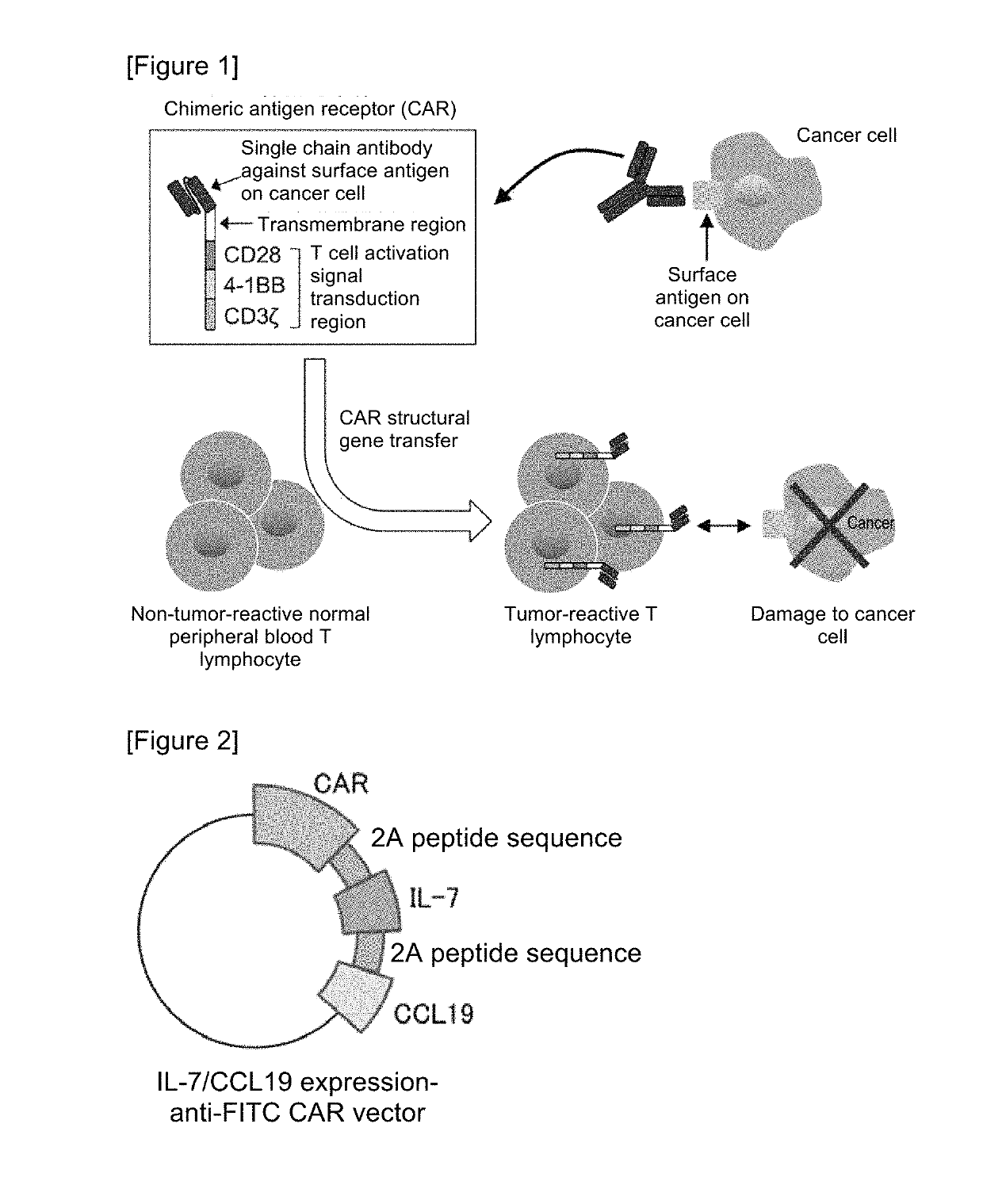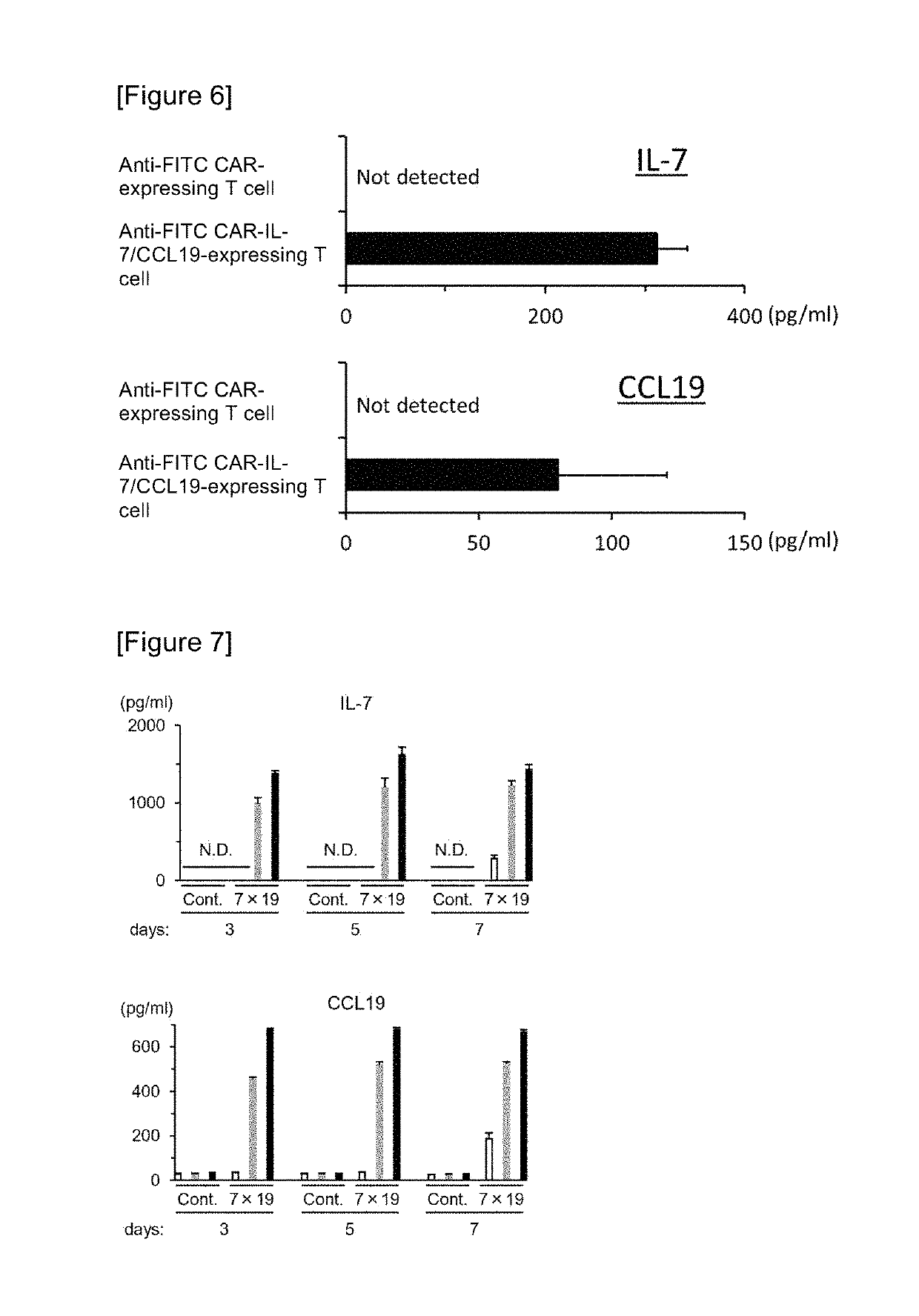Car expression vector and car-expressing T cells
a car-expressing t cell and expression vector technology, applied in the field of car-expressing t cells, can solve the problems that car-t cells have not yet attained a solid cancer treatment effect, conventional car-t cells do not sufficiently potentiate the immunity-inducing effect of car-t cells on endogenous t cells, etc., and achieve a strong cancer treatment effect.
- Summary
- Abstract
- Description
- Claims
- Application Information
AI Technical Summary
Benefits of technology
Problems solved by technology
Method used
Image
Examples
example 1
[Preparation of T Cells Expressing IL-7 and CCL19]
(Selection of T Cell Immune Function-Enhancing Factor)
[0097]At least several hundred different types of molecules that can control the functions of T cells are present in vivo. The inventors first selected IL-7 and CCL19 from among an enormous number of combinations on the basis of the previous findings or experiments, as control molecules for further enhancing the antitumor effect of CAR-T cells, and also selected the combination of these two molecules, i.e., the combination of IL-7 and CCL19, not each alone. The inventors prepared a vector for the coexpression of these T cell immune function-enhancing factors and CAR.
[0098]The IL-7 is a cytokine essential for the survival of T cells and is produced by non-hematopoietic cells such as stromal cells of the bone marrow, the thymus, and lymphatic organs or tissues. On the other hand, T cells themselves are hardly found to have the ability to produce IL-7.
[0099]The CCL19 is mainly produc...
example 2
[CAR Expression Assay by Flow Cytometry]
(Flow Cytometry Analysis)
[0106]The expression level of CAR recognizing FITC as a model antigen was analyzed by two-color flow cytometry. The prepared anti-FITC CAR-IL-7 / CCL19-expressing T cells were cultured in the presence of FITC-bound dextran and an allophycocyanin (APC)-bound anti-CD8 monoclonal antibody (53-6.7 manufactured by Affymetrix, Inc.). EC800 (manufactured by Sony Corp.) was used in the flow cytometry, and the data was analyzed using FlowJo software (manufactured by Tree Star, Inc.).
[0107]The expression level of CAR recognizing human CD20 was also analyzed by two-color flow cytometry. The prepared anti-human CD20 CAR-IL-7 / CCL19-expressing T cells were analyzed using biotinylated protein L and APC-bound streptavidin.
(Results)
[0108]The results are shown in FIGS. 3 to 5. In FIG. 3, the left graph depicts the results about an unstained CAR sample (FITC-bound dextran was not added) of the anti-FITC CAR-IL-7 / CCL19-expressing T cells, a...
example 3
[Secretion of IL-7 and CCL19]
(Measurement of IL-7 and CCL19 Concentrations in Culture Supernatant of Anti-FITC CAR-IL-7 / CCL19-Expressing T Cells-1)
[0109]The prepared anti-FITC CAR-IL-7 / CCL19-expressing T cells or anti-FITC CAR-expressing T cells were stimulated with 1 μg / ml immobilized FITC-bound trastuzumab and cultured for 3 days. The supernatant was recovered, and the concentrations of IL-7 and CCL19 were measured using a commercially available ELISA kit (manufactured by R&D systems, Inc.). The results are shown in FIG. 6.
(Results)
[0110]As shown in FIG. 6, in the culture supernatant, IL-7 was detected at 300 pg / ml or larger, and CCL19 was detected at 75 pg / ml or larger. Thus, it was confirmed that: the anti-FITC CAR-IL-7 / CCL19-expressing T cells express IL-7 and CCL19; and the expressed IL-7 and CCL19 are secreted to the outside of the cells. IL-7 and CCL19 from the control anti-FITC CAR-expressing T cells both fell below the detection limit (Not detected).
(Measurement of IL-7 an...
PUM
| Property | Measurement | Unit |
|---|---|---|
| pore size | aaaaa | aaaaa |
| volume | aaaaa | aaaaa |
| volume | aaaaa | aaaaa |
Abstract
Description
Claims
Application Information
 Login to View More
Login to View More - R&D
- Intellectual Property
- Life Sciences
- Materials
- Tech Scout
- Unparalleled Data Quality
- Higher Quality Content
- 60% Fewer Hallucinations
Browse by: Latest US Patents, China's latest patents, Technical Efficacy Thesaurus, Application Domain, Technology Topic, Popular Technical Reports.
© 2025 PatSnap. All rights reserved.Legal|Privacy policy|Modern Slavery Act Transparency Statement|Sitemap|About US| Contact US: help@patsnap.com



